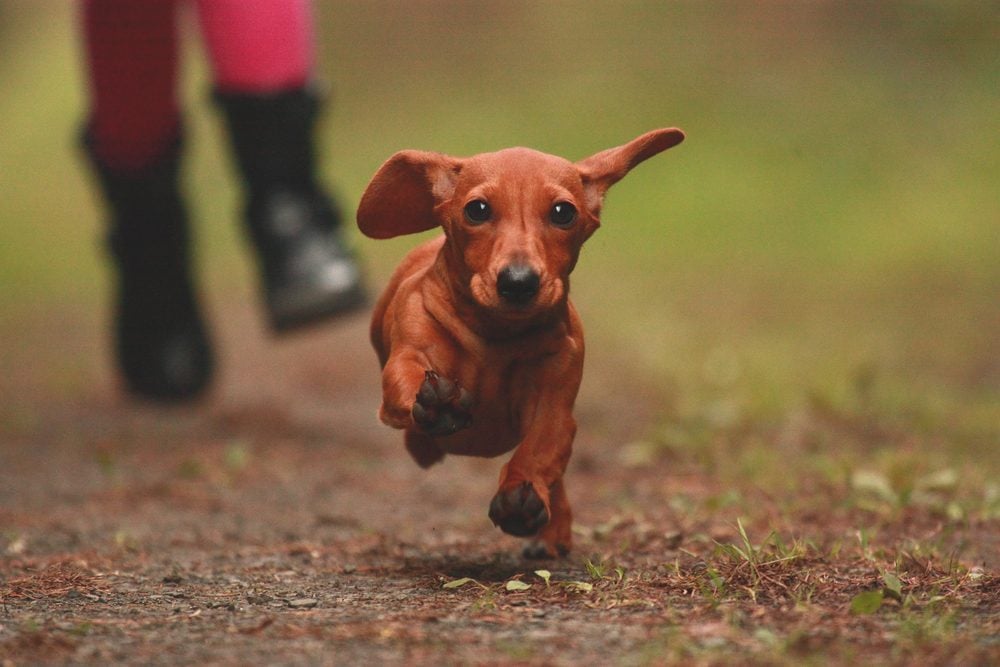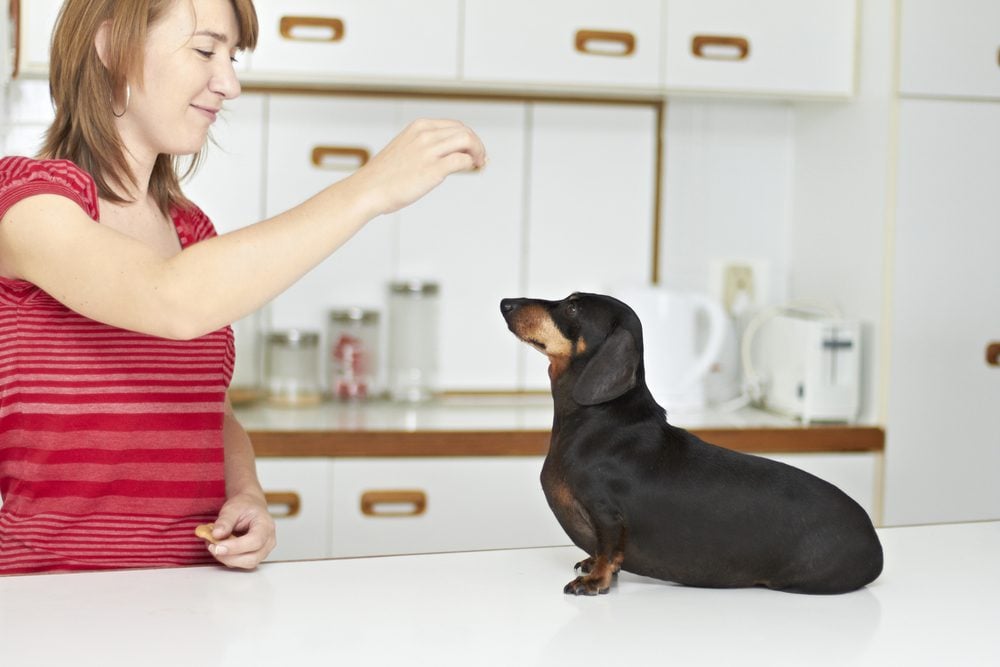Dachshund, wiener dog, doxie—these long-bodied pups go by a number of different monikers. They’re small in stature but have a big bark. It’s hard not to be drawn to this breed due to its adorably long snout, button nose, and unique body shape.
If you’re interested in owning a doxie or have already brought one home, then you need to know about training. Though Dachshunds are small, their training shouldn’t be neglected. Even small dogs need to be taught manners or they can be quite the terror, despite their size!
We’ll be discussing everything you need to know about training your wiener dog. You’ll learn more about the breed as well as the importance of effective communication and consistency. We’ll explain why positive reinforcement training is the best and why socialization is vital. Finally, we’ll share the commands we think should be a priority.
About the Breed
It’s important to learn about any breed you own or plan to own. This way, you can have a better idea of what to expect from your dog.
History
Did you know that Dachshunds are hunting dogs? The breed’s name is a German word meaning “badger dog.” These pups were originally bred to dig into badger dens and exterminate the critters inside. Dachshunds were seen as all-around hunting dogs able to work above and below ground; they were also used to flush, track, and retrieve game.
Today, Dachshunds are more commonly kept as companion animals, though you will find some owners who employ them as hunters. Regardless, their history as hunters still shines through in their temperament.
Temperament
Dachshunds tend to be loving dogs who are especially affectionate with their families. They can do well with kids, but only if they’ve been properly socialized during puppyhood. Similarly, Dachshunds are generally friendly toward strangers, though some can be protective.
Dachshunds are very vocal dogs who will bark at anything and everything. This makes them great watchdogs, though sometimes they’ll only be alerting you to a squirrel. Finally, they are quite clever and can be stubborn at times. However, this cleverness also makes the Dachshund a very trainable dog.
Your Dog Isn’t Human



Now that you understand a little more about the Dachshund, we’d like to talk about a mistake that many people make when training their dogs. This mistake is to treat their pups like a human.
Now, we’re not saying you shouldn’t love your dog; the bond we have with our pets is truly something special and we certainly believe it’s love. What we’re saying is that you need to consider what dogs can and can’t understand as well as how they learn.
For instance, the idea that dogs feel guilty after they do something wrong is prolific. However, there’s not much evidence to suggest that dogs are capable of feeling guilt. Guilt is a complex emotion that requires self-reflection and being able to understand when you’re in the wrong.
It’s far more likely that dogs have been taught to react “guiltily.” Dogs are incredible observers who are always watching our every move. They pick up cues in our body language that we may not even realize we’re making.
So, dogs learn that a scowl, a raised voice, a body that leans forward, a pointing finger, are bad. Then, they learn that cowering or other submissive behaviors tend to appease their owners. Oftentimes, dogs have no clue what they did wrong. Meanwhile, we humans assume the dog does know because they look guilty, and no progress is made.
If you don’t catch an undesirable behavior immediately, then your dog would never know to associate it with the punishment you doled out. Punishment, by the way, is not the best way to deal with undesirable behaviors, but we’ll talk more on that in our section about positive reinforcement.
To effectively train your dog, you need to think like a dog. The act of anthropomorphizing our dogs inhibits our ability to understand the true reasons behind certain behaviors. When you misconstrue a behavior because you’re treating your dog like a human, you often end up a step backward in your training.
Effective Communication
If you’re treating your dog too much like a human, then you may not be communicating effectively. Remember how we said dogs are incredibly observant? You can use this to your advantage.
Dogs pay attention to your body language, and so should you. This is one reason why dogs often pick up hand signals quicker than vocal cues. You can use your body language to encourage your dog to do certain things.
It’s pretty amazing that dogs like us at all considering how our body language would often be considered rude or even aggressive in doggy culture. If a dog stands directly facing another, body held tall, it’s seen as a threat. We humans stand like this in front of our dogs all the time!
By changing your body language to be less forward, you can encourage your pup to come more enthusiastically because you don’t look like you’re about to give a scolding. You can either lean back and shift your weight onto one leg or turn your body to the side.
Another important consideration about body language has to do with emotions. When we are nervous our dogs can pick up on that, just as they can pick up on when we’re confident. Sometimes, these emotions directly affect our dogs. A dog whose owner is tense in an already tense situation may be more likely to attack. Dogs look to us for guidance especially in stressful situations, so even if you’re not feeling confident, do your best to fake it.
Aside from body language, effective communication is clear communication. When teaching your dog a new command, be careful not to repeat it. You want to say it only once; otherwise, your dog may learn to respond to a command only after you’ve said the word a certain number of times. Do you want your dog to “sit” or to “sit sit sit?”
Consistency
One of the most important aspects of training is consistency. Consistency has two meanings. The first is that you regularly work on training your dog. The second, and perhaps most important, is that don’t send mixed messages.
For instance, if your dog is not allowed to jump on you when you’re wearing dress clothes, then they shouldn’t be allowed to jump on you when you’re wearing tattered work clothes, either. Along with this, everyone in your family needs to be on the same page about what your dog is or isn’t allowed to do as well as which training techniques and commands you are using.
You shouldn’t have one family member saying “down” and meaning “put all four feet on the floor” and another family member saying it and meaning “lie down.” When you are inconsistent, your dog has a harder time understanding what it is you want, and thus learns at a slower pace or even fails to learn certain skills altogether.
Positive Reinforcement



The best way to train your dog is using positive reinforcement. Positive reinforcement rewards your dog for performing desirable behaviors. As a result, dogs are motivated to learn, find training entertaining, and often learn faster than when other techniques are used. This type of training will also strengthen the bond between you and your dog.
Punishment-based training is still relatively prevalent despite the big boom in popularity that positive reinforcement has seen thanks to advocates and social media (and science!). However, we do not recommend this type of training because it negatively impacts the bond between you and your dog.
Even if your dog shows obedience, it is earned through fear. Punishment-based training can exacerbate behavioral problems because dogs can become so fearful that they lash out or develop anxiety issues that result in other problems (such as submissive urination).
Furthermore, it is easier to teach a dog what to do rather than what not to do. If you simply tell your dog “no” and punish them for a certain behavior, they may stop doing it. However, they may also replace that behavior with another undesirable behavior.
Positive reinforcement, on the other hand, seeks to redirect unwanted behaviors into acceptable ones. For instance, a dog that jumps when people come through the door can be taught to sit or lie down instead of jumping. A dog that is just punished and told no may struggle to understand what is expected of them.
Clicker Training
Clicker training is a type of positive reinforcement training that uses a tool called a clicker to mark when a dog has performed a desired action. Dogs are taught that the clicking sound means they’ve earned a reward. The clicker allows owners to mark behaviors with more accuracy.
Non-clicker training methods require rewards to be given immediately. With clicker training, however, the dog associates the behavior with the sound of the click, so it is okay if the reward is somewhat delayed because the dog already knows they have earned it and why.
Some dogs learn faster with clicker training because it better helps them understand exactly when they performed the action that results in a reward. It’s a great method for training Dachshunds and other breeds.
Manage Distractions
When you first begin training your Dachshund, it’s important to manage distractions. You need your dog to be completely tuned into you in order for them to learn a skill reliably. If there’s a lot of raucous going on, they may be more likely to focus on that instead of you.
You should start in a quiet room inside your home. Once your doxie has grasped the skill you are teaching and reliably responds to your command, then you can move to a place with more distractions, like your yard. It’s familiar enough that you should be able to focus your doxie’s attention on you but distracting enough that your pup can learn to listen amid distractions.
You want to train a skill starting in an area with the fewest distractions possible, then move to a location with slightly more distractions once the dog has mastered the skill. Then, have the dog master the skill in the new space with even more distractions. Keep increasing the difficulty until your Dachshund will listen to you no matter what’s going on around you.
Socialization and Handling
People don’t always think of socialization as training because you are not teaching your dog commands. However, obedience training isn’t the only type of dog training out there. Socialization teaches your dog to be calm in the face of anything whether that be fireworks, car rides, meeting other dogs, or meeting new people.
Unfortunately, the critical period for socialization is rather short; it occurs within the first three months of a dog’s life. Within this period, you need to expose your puppy to as many stimuli as possible. Meet different people wearing different clothing items, meet other dogs, and take your dog to different locations. Be sure to make all of these positive experiences by offering rewards.
You can think of handling as a specific type of socialization. You need to get your dog used to being touched or having tools used on them. You’ll want to pick up and touch paws, lift the dog’s lips to inspect their teeth, and check their ears.
Make sure to expose your pup to nail clippers and grinders, brushes, and other grooming tools. Don’t forget to get them used to baths, too.
There are so many things you need to expose your wiener dog to during puppyhood to ensure they don’t become fearful in the future. As long as you make these new experiences positive while they are puppies, they’ll be calm when they’re older.
Three Commands to Teach Your Dachshund



There are many skills your Dachshund should learn when they’re a puppy and throughout their lifetime. However, these are some that we feel deserve priority.
Come
“Come” isn’t just a useful skill, but a lifesaving one. If you have a dog that stops everything to come to you, then you could save them from running out into a busy street, for instance.
Sit
“Sit” is one of the easiest commands for a dog to learn, and it’s very useful. You can use “sit” to put your dog into a calm position during moments of excitement.
Leave It
Because Dachshunds have hunting instincts, “leave it” is a great skill to teach. Not only can you get your dog to leave objects alone, but you can also get them to leave animals alone (though this takes a lot of practice!).
Practice, Patience, and Consistency Makes Perfect
Training a Dachshund is a commitment; it takes patience, consistency, and time. However, it’s worth it as the result is a well-mannered pup that you can bring just about anywhere!
To effectively train your Dachshund, you need to think like a dog instead of a human. This will help you communicate with your pup better. Though there are many types of training, we recommend positive reinforcement. It’s the most humane method and it also gets great results.
While obedience training is important, don’t forget to work on socialization and handling, too! Exposing your doxie to a number of sights, sounds, and sensations while they’re a puppy will help them be calm during certain situations in the future.
Dachshund puppies are clever, loving, and super adorable. Like any puppy, they need someone to teach them the ropes. Train with love, patience, and consistency, and you’re certain to raise a well-behaved Dachshund.
